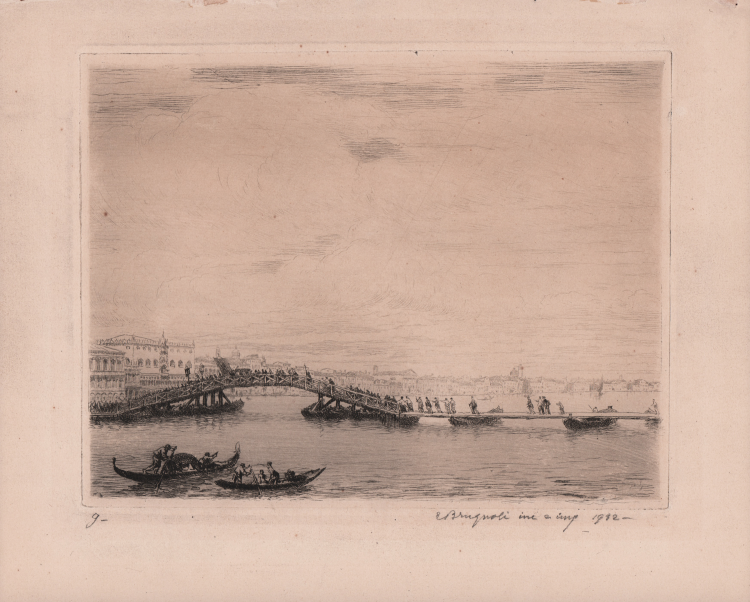



| Reference: | S42287 |
| Author | Emanuele Brugnoli |
| Year: | 1932 |
| Measures: | 230 x 185 mm |


| Reference: | S42287 |
| Author | Emanuele Brugnoli |
| Year: | 1932 |
| Measures: | 230 x 185 mm |
Etching, 1932, signed and dated in pencil at lower right "E. Brugnoli inc e imp 1932".
Beautiful proof, on contemporary paper, with margins, in excellent condition.
Emanule Brugnoli studied at the Academy of his city, student of the set designer Valentino Solmi. Suicide of the master, he went to Venice to spend a few weeks, but the city of the Lagoon conquered him and since 1880 he remained in Venice, devoting himself to portray those views characteristic of watercolor and etching. In 1912 he was appointed professor of watercolor and engraving in the Academy, where he was born precisely the school etching that earned so much fame. In a confession made to Luigi Servolini, Brugnoli indicated James Whistler as his true master in the art of etching. He was an assiduous exhibitor at the Internazionali Veneziane. All his works in watercolor and etching depict canals, lagoons, festivals, popular Venetian scenes.
Emanuele Brugnoli Bologna 2 settembre 1859 - Venezia 22 marzo 1944
|
He was born in Bologna on September 2, 1859. He studied at the Academy of his city, where he was the favorite pupil of the set designer Valentino Solmi. Suicidatosi the teacher, he went to Venice to spend a few weeks, but the city of the lagoon conquers him and 1880 there he settled. Here it enters in contact with Tito, Serena, Favretto and Milesi and it is devoted mainly to portray views and lagoon landscapes. His production is characterized mainly by watercolor, painting technique for which he shows to have an extraordinary ability. In 1861 he went to London to participate in the Exposition of Italian watercolorists and participates in numerous other exhibitions abroad. He took part in 1886 at the Florentine Promotrice, and in 1888 all'Esposizione Emiliana in Bologna. He participated in the second edition of the Venice Biennale (1899) and the following from 1901 to 1907 and from 1920 to 1934. In 1912 he was appointed professor of watercolor and engraving at the Academy of Fine Arts in Venice where he directed the Scuola Libera di Incisione until 1932. Although the fame of Brugnoli is linked mainly to watercolors, he is also dedicated with great passion to the technique of etching, indicating in the figure of Whistler his true master. He regularly exhibited at the International Venetian and is particularly noted by critics following the purchase of one of his watercolors, A canal in Venice, by the Emperor of Germany William II. He died in Venice on March 22, 1944.
|
Emanuele Brugnoli Bologna 2 settembre 1859 - Venezia 22 marzo 1944
|
He was born in Bologna on September 2, 1859. He studied at the Academy of his city, where he was the favorite pupil of the set designer Valentino Solmi. Suicidatosi the teacher, he went to Venice to spend a few weeks, but the city of the lagoon conquers him and 1880 there he settled. Here it enters in contact with Tito, Serena, Favretto and Milesi and it is devoted mainly to portray views and lagoon landscapes. His production is characterized mainly by watercolor, painting technique for which he shows to have an extraordinary ability. In 1861 he went to London to participate in the Exposition of Italian watercolorists and participates in numerous other exhibitions abroad. He took part in 1886 at the Florentine Promotrice, and in 1888 all'Esposizione Emiliana in Bologna. He participated in the second edition of the Venice Biennale (1899) and the following from 1901 to 1907 and from 1920 to 1934. In 1912 he was appointed professor of watercolor and engraving at the Academy of Fine Arts in Venice where he directed the Scuola Libera di Incisione until 1932. Although the fame of Brugnoli is linked mainly to watercolors, he is also dedicated with great passion to the technique of etching, indicating in the figure of Whistler his true master. He regularly exhibited at the International Venetian and is particularly noted by critics following the purchase of one of his watercolors, A canal in Venice, by the Emperor of Germany William II. He died in Venice on March 22, 1944.
|